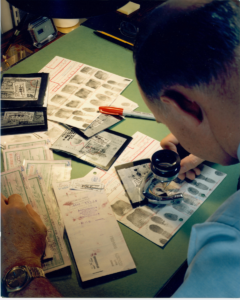 A fingerprint analyst is someone who works in the field of forensics who analyzes fingerprints collected at crime scenes. A fingerprint analyst can also be called a “latent print examiner.” Analysts collect evidence at the crime scene and then scan it in national databases. The most well-known of these databases is the FBI’s Integrated Automated Fingerprint Identification System (IAFIS), to which most law enforcement agencies submit any fingerprints that they need to be identified.
A fingerprint analyst is someone who works in the field of forensics who analyzes fingerprints collected at crime scenes. A fingerprint analyst can also be called a “latent print examiner.” Analysts collect evidence at the crime scene and then scan it in national databases. The most well-known of these databases is the FBI’s Integrated Automated Fingerprint Identification System (IAFIS), to which most law enforcement agencies submit any fingerprints that they need to be identified.
The job of a fingerprint analyst generally requires at least a bachelor’s degree. It is recommended that this degree comes in the science fields – chemistry or biology, preferably with a focus on forensics, if offered. To become a certified fingerprint analyst, there is a test from the International Association for Identification (IAI) known as the Tenprint Certification test. The more advanced test is known as the IAI Certified Latent Print Examiner certification. Certified fingerprint analysts can testify in trials and be seen as valid witnesses.
Other requirements are familiar to many other jobs – a background check, US citizenship, and the ability to pass a drug test. However, unlike most jobs, a fingerprint analyst must also obtain a security clearance if they are to work in any governmental-based forensic analyst positions.
A fingerprint analyst has to not only be familiar with the scientific procedure and crime scene procedure – since the analyst is one of the first people on the scene after the first responders – but also must be able to understand the computer systems that are involved with the job. It is a unique combination of the two disciplines.
